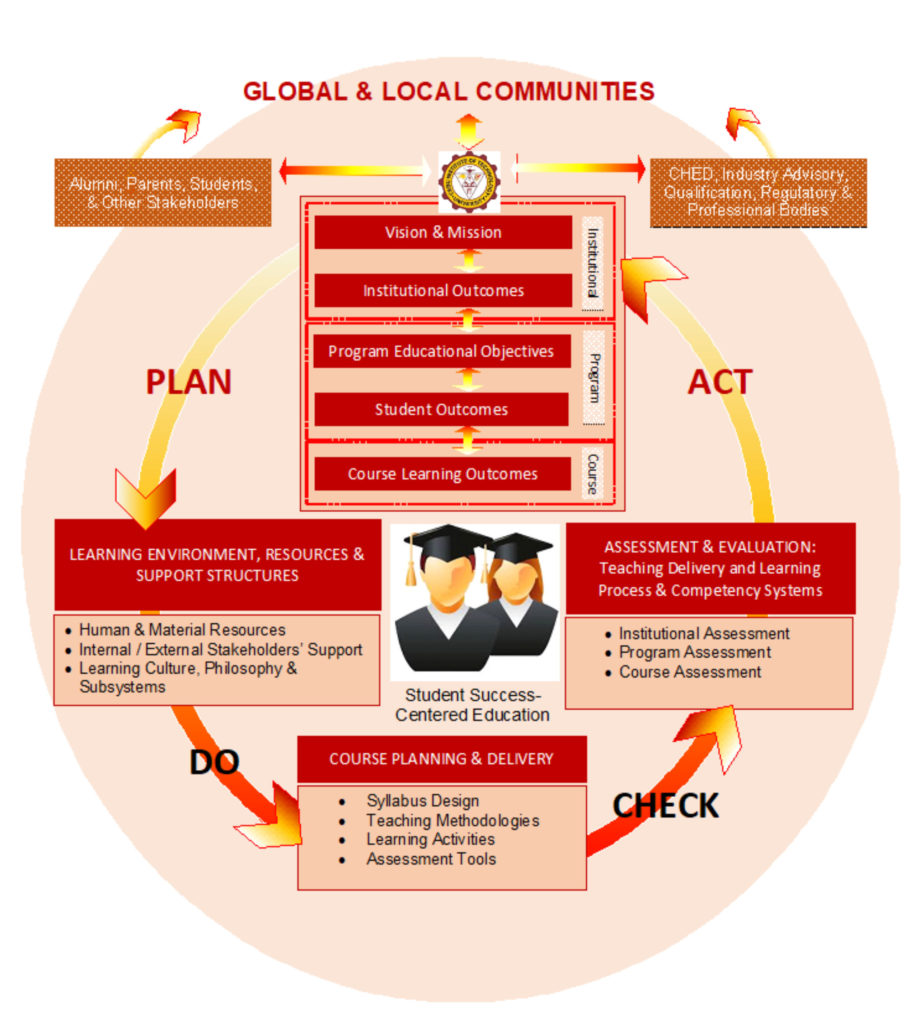
Our Outcomes-Based Education (OBE) framework is profoundly anchored on developing Technologians who are ingrained with values and competence with science and technology at its core in order to meaningfully respond to the needs of the community in both local and global contexts. Adhering to its education philosophy of ensuring student success, the outcomes at the institutional, program and course levels are pivoted on a learner-centered standpoint to support the CIT University Motto Virtus in Scientia et Tecnologia. Moreover, continuous quality improvement mechanisms are and shall persistently be devised and revised in its unrelenting quest to produce graduates in congruence with globally acceptable standards.
OBE is an educational process which is focused on attaining what the individual student can and must do with what he or she knows. The outcome-based approach revolves around three components: (a) outcomes – the educational aims and values, (b) teaching, learning & assessment methods – the methodology to enable the intended learning, and (c) criteria – how learning is assessed in relation to the expected outcome.
The CIT University OBE framework adapts the PDCA cycle to discover relevant contemporary alternatives to incessantly develop the learners for their better advancement of graduate placement destinations. The OBE learning process can be stated into four steps:
The university OBE framework fundamentally includes the following components:
Program Educational Outcomes (PEOs)
Program Educational Objectives are broad statements that describe the career and professional accomplishments that the program is preparing graduates to achieve within three to five years after graduation.
Student or Program Outcomes (SOs)
Student Outcomes are narrower statements that describe what the students are expected to know and be able to do by the time of graduation. These relate to the knowledge (cognitive), skills (psychomotor), and behavior (affective) that the student acquires through the program.
Curriculum Map
The Curriculum Map summarizes the design of the curriculum in its contribution to CHED-set student outcomes. These courses are identified as either introductory, enabling or demonstrating the specific intended outcomes. Each course then establishes the course learning outcomes (CLOs) which are statements that describe the knowledge or skills the students should acquire by the end of a particular academic requirement to help them understand why that knowledge and those skills will be useful to them. These CLOs are very specific to each individual course and are designed to support and be measurable against the student outcomes.
Outcomes-Based Teaching and Learning (OBTL) Delivery Process
Teaching methodologies and learning activities are devised to effectively and efficiently equip students with the competencies associated with each course synchronizing with the student outcomes.
Program Assessment and Evaluation Process
The teaching and learning delivery process is evaluated in consonance with the SOs and PEOs at different levels – course, program and institutional. The extent of how the expected outcomes are attained reflects the quality of the university in transforming its students to become productive graduates.
Continuous Quality Improvement (CQI) Process
The review of the process enables the university to uncover opportunities for improvement and sanction means to continually evolve learning structure and systems. CQI process captures and analyzes loopholes then formulate approaches in raising the bar to ensure increased likelihood of student success.